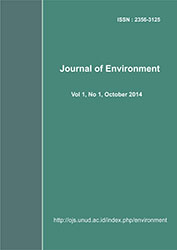Phytoplankton Diversity as Ecological Indicator in Jimbaran Bay Waters
Abstract
A study was carried out to evaluate the ecological condition in Jimbaran Bay Waters by using Phytoplankton Diversity Index. The study was conducted at Balangan, Pemuda, Jimbaran, Kedonganan, Kelan and Segara Beach located in Jimbaran Bay. Shannon-Wiener diversity index was used to analyze the ecological condition, supported by analysis on water quality including dissolved oxygen (DO), biological oxygen demand 5 days (BOD5), water pH, and water salinity. There were 51 species of phytoplankton classified to 5 classes had been observed from this study: Bacillariophycae, Cyanophyceae, Zygnemophyceae, Dinophyceae, and Chlorophyceae. Balangan beach showed higher diversity index (H) and evenness index (E) (H = 1.19; E = 0.29) compared to the other site (Pemuda: H = 0.89, E = 0.25; Jimbaran: H = 0.89, E = 0.26; Kedonganan: H = 0.96, E = 0.28; Kelan: H = 0.85, E = 0.20; and Segara: H = 0.91, E = 0.33). However, overall ecological condition showed diversity index more than 1 (H = 1.44; E = 0.27). Measurement of water quality showed that the highest quality of water was shown by Balangan Beach (DO 5.2 mg/L, pH 7.2, salinity 29 ppt, and BOD5 0.9 mg/L), while the lowest was shown by Kelan Beach (DO 4.2 mg/L, pH 7.2, salinity 29 ppt, and BOD5 2.9 mg/L). Result of the study showed that ecological status of Jimbaran Bay Waters was having moderate diversity, sufficient productivity, and medium ecological pressure (pollution).Downloads
Download data is not yet available.
Published
2014-10-03
How to Cite
PERWIRA, Ima Yudha; ULINUHA, Devi.
Phytoplankton Diversity as Ecological Indicator in Jimbaran Bay Waters.
Journal of Environment, [S.l.], v. 1, n. 1, oct. 2014.
ISSN 2356-3125.
Available at: <https://ojs.unud.ac.id/index.php/environment/article/view/11069>. Date accessed: 11 dec. 2025.
Issue
Section
Articles
Keywords
Phytoplankton; Diversity; Jimbaran Bay; Ecological; Indicator
Authors who publish with this journal agree to the following terms:
- All articles published by Journal of Environment and Graduate Study of Environmental Sciences, Udayana University are made available under an open access license worldwide immediately. This means everyone has free and unlimited access to the full-text of all articles published in Journal of Environment, and everyone is free to re-use the published material given proper accreditation/citation of the original publication. Open access publication is supported by authors' institutes or research funding agency by payment of a comparatively article processing charge for accepted articles (See Author Fees). Journal of Environment and Graduate Study of Environmental Sciences, Udayana University publish articles under the Creative Commons Attribution License.
- Authors are able to enter into separate, additional contractual arrangements for the non-exclusive distribution of the journal's published version of the work (e.g., post it to an institutional repository or publish it in a book), with an acknowledgement of its initial publication in this journal.
- Authors are permitted and encouraged to post their work online (e.g., in institutional repositories or on their website) prior to and during the submission process, as it can lead to productive exchanges, as well as earlier and greater citation of published work (See The Effect of Open Access).


